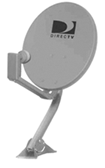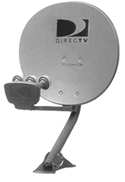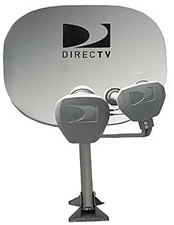
![]()
My Personal View
You've all seen the ads on TV: The Cable company claims DBS (Direct Broadcast Satellite is foolish, and the DBS companies rag on Cable. Who should you believe?
I subscribed to cable for years. In 2002 though, I switched to DirecTV, and it's one of the best decisions I ever made. Here are the facts, based on my experience.
-
Can you get local channels with DirecTV? The answer for most people is yes. Not only that, in 2006 DirecTV started rolling out local Channels in HD.
-
Do landlords usually allow DirecTV dishes? Unfortunately, no. It doesn't hurt to ask though. If you rent, but have a view of the southern sky, carefully explain what you'd like to do, and be willing to work with the landlord on finding an inconspicuous spot to mount the dish. be sure to explain that it's only 18" in diameter, about the size of an extra-large pizza.
-
Do you lose the signal when it rains? Not usually. It takes a major storm to block the signal, and those usually pass quickly. I've experienced half a dozen outages in a year, and they averaged 10 - 15 minutes. I had more minutes of outage per year with Cable. This would happen anytime water got into a connection, or a tree branch fell on a line. Cable outages averaged 2 - 3 hours.
-
Cable claims that it's expensive to set up DirecTV for multiple TVs... Wrong! Prior to 2006, DirecTV sold it's receivers outright, and even then you could find deals that gave you the receivers for free. Today DirecTV leases the equipment in much the same way as the cable companies. From the customer standpoint, the deal looks pretty much the same: You can get all the equipment you need for a four TV system for free, and you pay a monthly fee for each receiver. If you're new to DirecTV, my advice is to order directly from them. There are a multitude of independent vendors and installers, but all they're really doing is reselling DirecTV's current offer. If you're already a customer and looking to expand your system, here are a few things to keep in mind.
In the beginning, DirecTV was very simple. There are one satellite in orbit, (Sat A at 101°) and you got a round dish, 18" across, with a single LNB that provided two outputs. This type of dish will support two receivers with no additional equipment needed. To add two more TVs, one needs a two input / four output Multiswitch that currently costs around $15., enough RG-6 coax to reach the new locations and two more receivers. That's it! (Well, almost. Each receiver needs to be attached to a phone line as well.) Need to hook up more than four receivers? Quality 8 port Multiswitches are available for just over $60. I've created a diagram (below) that shows a Phase I system configured for four TVs.
![[Diagram of Phase I dish connected to four receivers through a 2 X 4 Multiswitch]](images/source photos/p1_system.jpg)
With the launches of Sat B (at 119°) and Sat C (at 110°), things became a lot more "interesting." Many channels were duplicated, but new channels were also added, including some High Definition (HD), and local broadcast channels for major markets. With more than one target to aim at, the antennas had to change from round to oval. (18" X 20") The Phase II dish had two LNBs, and room to mount a third. To merge the signals however, an external multiswitch was a must. The Phase II Plus antenna had the third LNB for Sat C already installed, plus it had a built in multiswitch. The Phase III dish is basically a refinement of the II Plus, with all three LNBs contained in a single module. The Phase III dish will support up to four receivers with no additional equipment. For additional receivers, a four input multiswitch is needed, and a 4-In / 8-Out unit can be purchased for just over $60. The diagram below shows a Phase III system, and just how quickly one can use up eight outputs. If even more outputs are needed, larger multiswitches are available, (at a substantially higher cost) or 8-Out units can be cascaded.
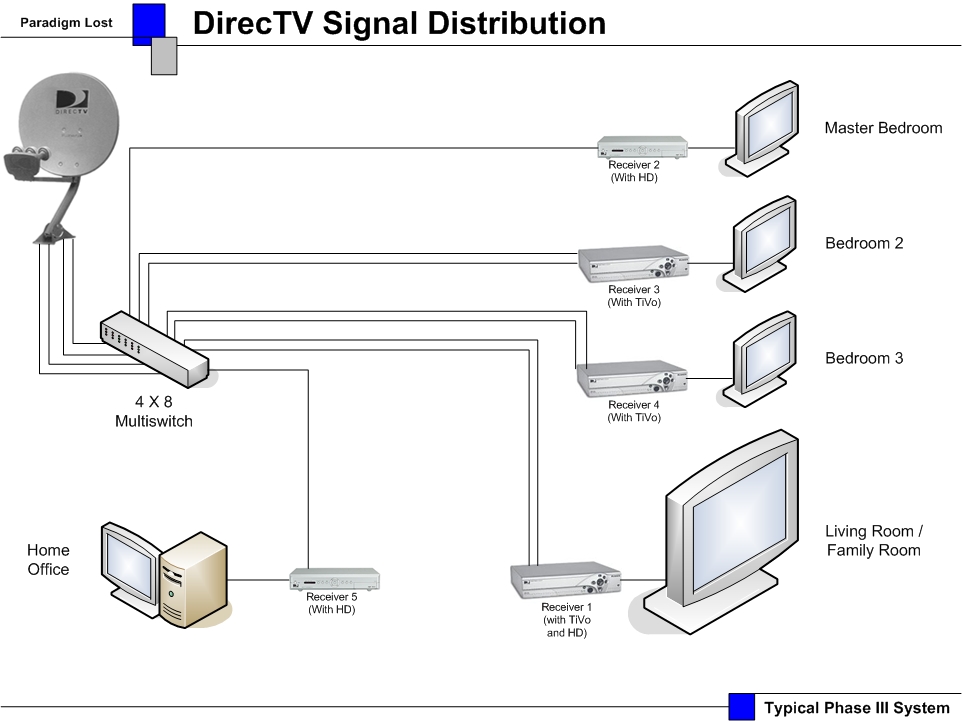
The observant reader will have noticed that there are two cables running to the TiVo receivers. That is because each Receiver with TiVo (or DirecTV's new proprietary DVR technology) has two tuners, and each tuner requires it's own feed from the dish. It's almost like having two receivers, but better. You can watch one program while recording a second, or record two at once while watching either of the two, or perhaps a third program that was recorded previously. If you've never seen a DVR in action, run to your nearest TV dealer and ask for a demo. You won't believe how easy and convenient they are.
-
Can I get my local channels in HD? That answer to that, depends on where you live. In Pittsburgh PA we've had them since April of 2006, and we're not exactly a top ten market. Expert Satellite maintains a list on their website here, with information on local channel availability. There's also a good news/bad news situation, when it comes to local channels in HD: A better data compression system has been introduced, but that means new satellites, and the equipment has changed again. The new "birds" are located at 99° and 103°. Rather than using the older MP2 compression, they utilize MP4, which results in a higher fidelity picture. The "old" HD receivers will not pick up these new channels, so DirecTV will be happy to lease you a new HD receiver, while the old one gathers dust in you attic. A new dish is required as well, and it's a monster. The AT-9 measures 25.5" (h) x 29.5" (W), and weighs 32 lbs, including the J-mount mast. It incorporates five LNBs, and an internal 5 X 4 multiswitch. As of this writing a new slightly smaller dish has been introduced, the AU-9S. I've not yet found a review of this antenna on-line, so I currently have no idea if there are performance issues. I do know that the first 17,000 shipped had defective LNBs that require the use of an external wideband multiswitch, regardless of the number of tuners being connected. Technically, a wideband multiswitch is also required, if you need to support more than four tuners. It has been my personal experience that my old Terk BMS-58 5 X 8 multiswitch works just fine, but that is not a guarantee by me. The Zinwell WB68 is a 6-In/8-Out unit approved by DirecTV, and available for around $80.
-
What about broadband Internet access? You have three options here. If you already have broadband over cable, go ahead and keep it! You're not required to subscribe to the TV service, just to get the Internet. If you're lucky like me, you can get DSL from the phone company. With DSL, you're not sharing bandwidth with the neighborhood, like you do with Cable broadband. -OR- Check out HughesNet! With HughesNet, your satellite dish comes equipped with a transmitter, and all your uploads as well as downloads travel through the satellite. This is perfect for people in rural areas.
My current configuration includes an AT-9 dish, a Terk BMS-58 multiswitch, one dual tuner Hughes receiver with TiVo, one DirecTV brand dual tuner DVR, and one DirecTV brand High Definition receiver. Below are photos (not to scale) of the Phase I, Phase III, and AT-9 dishes. I'm also including a photo of my Terk multiswitch, as installed. The white coax with the red band is the one I use to feed DC power to the switch.
|
|
|
|
|
Phase I |
Phase III |
AT-9 |
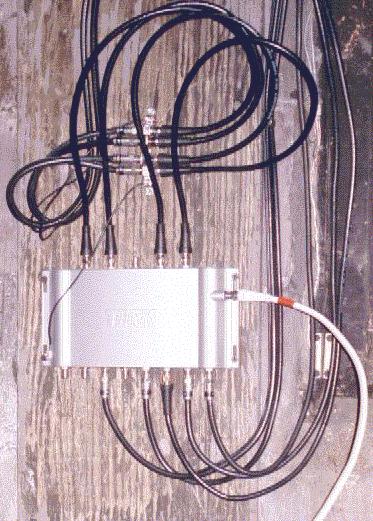
Ready to get started? Here's a link to my on-line store, which I've created in association with Amazon.com. I've selected multiswitches and a few other technology goodies, and placed them in a nice, focused format where it's easy to find what you need.










